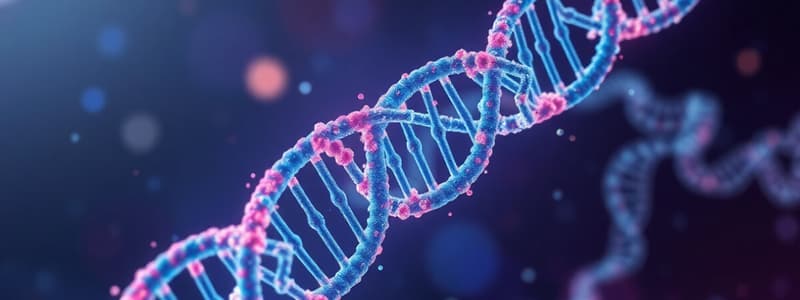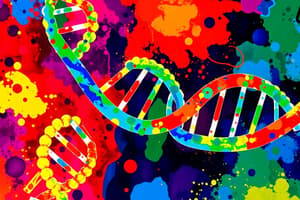Podcast
Questions and Answers
Which component is directly involved in the process of phosphorylation?
Which component is directly involved in the process of phosphorylation?
- CAMP (correct)
- Insulin
- Adenosine
- Glycosidic bond
Which term best describes the reaction that involves the removal of a phosphate group?
Which term best describes the reaction that involves the removal of a phosphate group?
- Condensation
- Glycosylation
- Dephosphorylation (correct)
- Phosphorylation
In the context of DNA, which element is stated to be transformed to form Adenosine?
In the context of DNA, which element is stated to be transformed to form Adenosine?
- Cytosine
- Thymine
- Adenine (correct)
- Guanine
Which type of bond is primarily involved in the formation of nucleic acids?
Which type of bond is primarily involved in the formation of nucleic acids?
What is considered the end product of dephosphorylation in metabolic processes?
What is considered the end product of dephosphorylation in metabolic processes?
Flashcards
DNA Structure
DNA Structure
DNA is a complex molecule shaped in a double helix.
Phosphorylation
Phosphorylation
Adding a phosphate group to a molecule.
Dephosphorylation
Dephosphorylation
Removing a phosphate group from a molecule.
Adenosine
Adenosine
Signup and view all the flashcards
Glycosidic bond
Glycosidic bond
Signup and view all the flashcards
Study Notes
DNA and Molecular Biology
- DNA and RNA are nucleic acids
- Nucleotides are the structural units of nucleic acids
- Nucleotides are composed of a nitrogenous base, a pentose sugar, and a phosphate group
- Nucleosides are composed of a nitrogenous base and a pentose sugar
- Purines include adenine and guanine
- Pyrimidines include cytosine, uracil, and thymine
- Ribose is the pentose sugar in RNA
- Deoxyribose is the pentose sugar in DNA
- Major pyrimidines include uracil, thymine, and cytosine
- Minor pyrimidines include dihydro uracil and methyl cytosine (hydroxy methyl cytosine)
- Major purines include adenine and guanine
- Oxy purines include hypoxanthine and xanthine, Uric acid is the end product of purine catabolism
- Methylated purines include caffeine, theophylline, theobromine
- Nucleotides are named based on the nitrogenous base
- Nucleosides are named based on their nitrogenous base
- e.g., Adenylic acid (AMP) is the monophosphate form of Adenosine
- ATP is a source of energy in the body
- High-energy bonds between phosphate groups
- Signaling second messenger (hormone 2nd messenger)
- cAMP (cyclic AMP) and cGMP (cyclic GMP)
- cAMP can activate protein Kinase A causing phosphorylation
- cAMP acts in signal transduction
- Methylated derivatives are important for biosynthesis
- SAM (S-Adenosyl Methionine) is the most important methyl donor
- PAPS (phosphoadenosine 5'-phosphosulfate) is a sulfate donor
- Other forms of RNA: snRNA, miRNA, and siRNA
Nucleosides and Nucleotides
- Nucleosides are formed by attaching a nitrogenous base to a pentose sugar via a glycosidic bond.
- This attachment is at position 1' on the pentose sugar.
- Position 9' for purine and 1' for pyrimidine
- Nucleotides are formed by attaching one or more phosphate groups to the 5' carbon of the pentose sugar in a nucleoside.
- The attachment is by a phosphate ester bond.
- Carbon atoms of the pentose sugar are numbered as 1', 2', 3', 4', and 5'.
Free Nucleosides and Nucleotides
- Nucleotides and nucleosides are the building blocks of DNA and RNA
- They play important roles in many biochemical functions, including energy transduction and signaling pathways.
Nucleic Acids
- Nucleic acids are polymers of nucleotides, which are composed of a nitrogenous base, pentose sugar, and phosphate group.
- There are two main types: DNA and RNA.
- DNA typically has a double helix structure, whereas RNA is usually single-stranded
- Primary structure: Sequence of nucleotides along a polynucleotide strand
- Secondary structure: Specific three-dimensional arrangement of a polynucleotide strand. For example, DNA forming a double helix
- Tertiary structure is the overall 3D arrangement of a nucleic acid strand or its double helix
- DNA structure has a double helix.
- Stability is maintained by hydrogen bonds between nitrogenous bases, Van der Waals forces, and hydrophobic interactions
- DNA is primarily linear but also exists as supercoiled circular forms.
- Mitochondria, and some types of bacteria contain circular DNA
RNA Structure
- RNA is a polymer of ribonucleotides
- RNA is single-stranded
- Different types of RNA perform different roles in protein synthesis
- mRNA carries the genetic code from DNA to the ribosome.
- tRNA transports amino acids to the ribosome.
- rRNA plays a structural role in ribosome.
Other Forms of RNA
- Various non-coding RNAs play important roles in gene expression regulation and other cellular processes.
Mitochondrial DNA (mtDNA)
- mtDNA is a small, circular, double-stranded DNA molecule
- It is inherited maternally
- mtDNA codes for some proteins and RNA molecules crucial for energy production in mitochondria.
Genetic Terminology
- Genes are sequences of DNA that code for proteins.
- Alleles are different forms of a gene.
- The genome is the complete set of genetic material in an organism.
- Exons are the coding regions of a gene, while introns are the non-coding regions.
- Phenotype is the observable characteristics of an organism.
- Genotype is the genetic makeup of an organism.
Studying That Suits You
Use AI to generate personalized quizzes and flashcards to suit your learning preferences.




